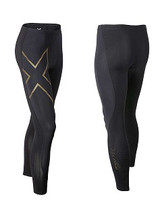Posted by A.J. Nygren on 13th Dec 2017
What is Compression?
On the start line of any race, you will likely see a handful of runners wearing one form or another of compression gear. Some wear compression socks, others, compression tights, and some wearing compression arm sleeves. Aside from the look, is there an advantage to wearing something that is just much tighter than normal athletic wear? The answer, largely, is yes. The reason that compression gear is popular stems not only from the fact that it is comfortable, but that it makes most athletes feel better during or after a hard workout. When people run very hard or for a longer period of time, the legs are subjected to a significant amount of stress and impact. The legs are also a crucial part of what is known as the “musculovenous pump.” When moving about at intensity, the leg muscles and especially the calves actually push blood back up the legs and into the heart. By wearing compression gear, those tissues are squeezed and are better able to take impact and allow blood to flow more easily out of the tissues. This has multiple advantages. Firstly, if used blood is pumped out efficiently, fresh oxygenated blood is pumped in more efficiently. Secondly, waste products from cells are going to be removed from tissues more easily. Combine those two effects, and boom, fresher legs.
The companies that manufacture compression gear have different philosophies as to how the compression should work and they make pieces of gear that are meant to be used at different times. For instance, 2xU makes a broad array of compression gear. They make a “perform” line of compression that is an excellent choice for those athletes who use them during training or an event. The fabrics used are lighter and more breathable but still provide enough squeeze to improve muscle alignment and decrease stress on impact. 2xU also makes a high-end line of compression that bears the name “Elite MCS” The MCS portion stands for “muscle compartment stamping.” On the inside of these garments, there is webbing that traces the shape of the muscle groups. The webbing will increase the compressive and supportive effects of the garment from the inside. These models are also suitable for training/racing as well as recovery. Another type of compression wear is manufactured by a company called CW-X. Their compression does not focus so much on bloodflow as much as supporting the wearer’s joints. The construction of their garments mimics that of kinesio-tape with thicker more compressive fabric wrapping the sides of the knees and hips. This style of compression gear is best worn during activity to make use of the stabilizing features.
Lastly, there is compression clothing designed specifically for recovery. 2xU makes a “refresh” line of compression wear that uses higher denier (denser) fabric that gives more firm compression to the tissues. Zoot makes a set of compression tights called the Ultra Recovery 2.0 CRx that goes all the way to the bottoms of the feet for maximum bloodflow through the lower body. As the names imply, these garments are best worn for extended periods of time (eight to twelve hours in my experience) after hard training or an event. Some people will even sleep in compression gear! What about those arm sleeves that we mentioned earlier? We understand now the benefits of compressing the lower legs but why the arms? The arms and the hands are extremities just like the feet and legs. When a runner has his or her arms bent at an angle for a number of hours in a longer race, some people find that their hands will swell and compression can help regulate that bloodflow. There is also the advantage of creating a more efficient system of bloodflow throughout the body. Compress the legs and arms, and the heart will have to work a bit less hard to keep things moving through the circulatory system.

